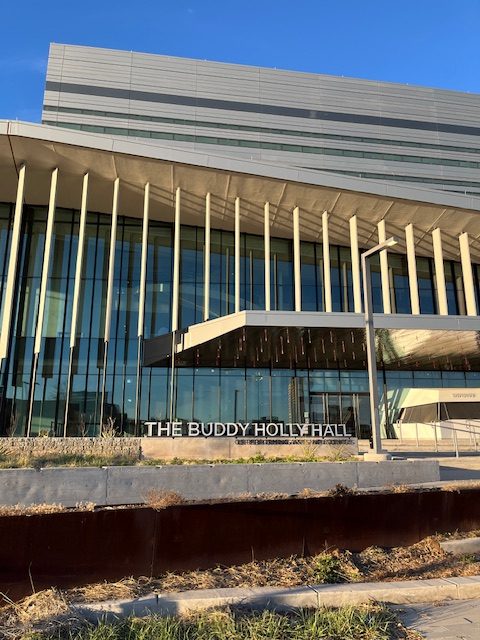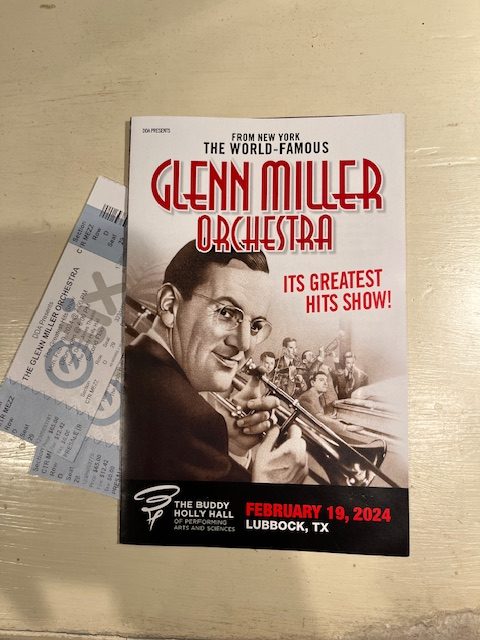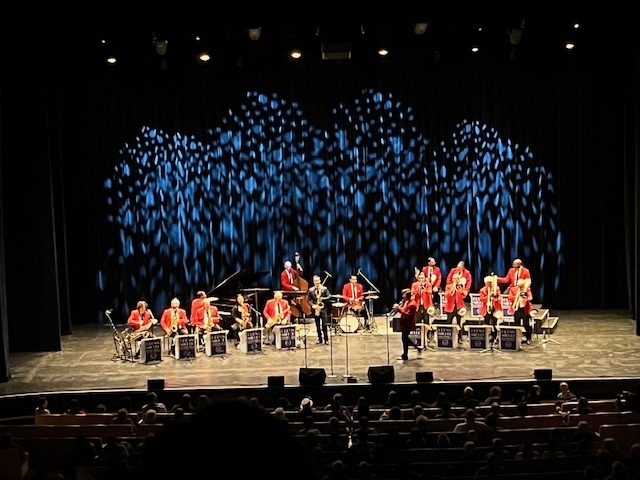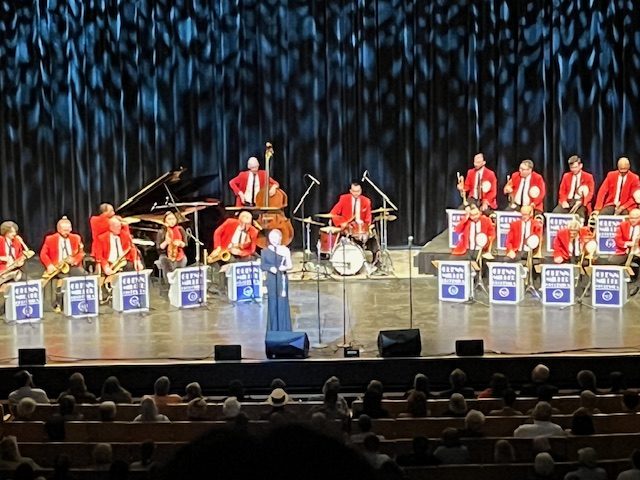Bill and I enjoyed a night of big band swing dance music at the Buddy Holly Hall last night.
The World Famous Glenn Miller Orchestra was in fine form.
This was Bill’s first visit to Buddy Holly Hall, so we arrived early, picked up my Will Call tickets, and checked the place out. We walked the spiral staircase to locate our seats in the mezzanine and then walked around a bit.
For those of you not growing up listening to Glenn Miller and other big bands of the late 30s, the 40s and early 50s like I did with my parents, you missed a real treat. I was born after the big band era was at its height and when Glenn Miller disappeared in 1944 over the English Channel near the end of WWII, but I grew up listening to his music, so I recognized his most popular songs that the band played for us that night. They started off with “String of Pearls,” one I recognized and like. Well, I liked all of them, but was not familiar with all of the selections the band played that night, a two hour concert with a short intermission. The time went fast as they interspersed many pieces with the hits I was familiar with and always enjoy hearing, notably “Chattanooga Choo Choo,” which was the first record in the music industry to sell a million copies and receive a gold record, along with “Tuxedo Junction.” “Pennsylvania Six-Five Thousand,” and “Moonlight Serenade.” That was the last selection they played, after which the featured singer, Jenny Swoish, grinned slyly and asked the audience if we would like an encore, which of course, we did, and they brought the house down with a rousing arrangement of “In the Mood,”
Glenn Miller was a musician pretty much his whole life. He was born in Clarinda, Iowa, in 1904 and went to grade school in North Platt, Nebraska, after which the family moved to Grant City, Missouri, where he earned enough money milking cows to buy his first trombone, which became his trademark instrument. He played in the town’s orchestra where he also played cornet and mandolin. The family moved to Fort Morgan, Colorado, where he made a name for himself as a football player but also formed his first band with his classmates. It wasn’t long after he graduated high school that he knew he wanted to be a professional musician, which became pretty obvious after he entered the University of Colorado in 1923 and spent most of this time going to auditions and playing gigs, and promptly failed three out of five classes. So he dropped out and got serious about his career in music.
But he did do some studying, this time in New York City learning the Schillinger System, a method of musical composition based on mathematical processes that comprised theories of rhythm, harmony, melody, counterpoint, form, and semantics. This system was also studied by Benny Goodman, another big band leader, and George Gershwin who composed my favorite “Rhapsody in Blue,” so even though it later lost credibility in the music world, it just had to have something good about it and had to have been a big influence on the the Glenn Miller big band sound. The critics may not have liked it, but the public sure did!
It was under Mr. Schillinger’s teaching that Glenn Miller composed something called “Miller’s Tune,” arranged it for big band and renamed it “Moonlight Serenade,” which became the band’s theme song; they always ended the night with it. Except for our concert when they did “In the Mood” last, which was a great way to end that night.
He went on to play and tour with other groups as the trombone soloist, but when Jack Teagarden joined Ben Pollack’s band, the solos went to him, and Glenn Miller decided his future would be in arranging and composing, although he still played the trombone in some arrangements. His first band from 1937 failed to make a name for itself, but by 1939, they went on to develop their own distinctive sound, and the Glenn Miller Orchestra was a hit with that first gold record coming out of that sound in 1942.
Miller had wanted to join the armed forces but was classified 3-A because he needed corrective lenses and was unlikely to be drafted. But he applied to the army air force with the plan to streamline modern military music and was accepted. He turned the band over to Harry James, who then made a name for himself. Glenn went on to boost soldiers’ morale with his new brand of military music with his Major Glenn Miller Army Air Forces orchestra and came to be known as the father of the modern military band.
It was during this time of serving his country that on a flight from London to meet the band in Paris, his plane went down over the English Channel and never was found. The plane went down on December 15, 1944; on December 16, 1945 he was officially declared dead. The band went on to play in Europe through V-E Day until August 1945, eventually disbanding in 1946.
But the music lives on and it was a real delight to hear it performed live, even if it was minus the mastermind of the big band concept. Good, live music is always so much better than a recording. I think it was the music director, Erik Stabnau, who served as master of ceremonies for the night. He shared a little history of each selection before they played, and several of the pieces came from movies back then. Speaking of movies, Jimmy Steward played Glenn Miller in a movie called The Glenn Miller Story (1954), and I can remember in that movie a scene where he gets his army band to up the tempo of a march that ups the morale of the troops. I suspect that’s not how it happened in real life, but it makes a good scene in the movie and it’s a great version of that march-typical of what came to be known as the Miller Sound. The movie may have several Hollywood touches that aren’t exactly true, but you get to hear all that music!
Most big bands, as I recall, also always had a female singer for some selections, and they had jenny Swoish, who sounded very typical of big band vocalists and added to the night. Another thing that added to the concert for me was the string bass, or, as I knew it growing up, a bass fiddle. A bass adds so much with its tump, tump, tump to bands large or small, and I enjoyed that, along with the tinkling of the piano in the appropriate places. I wanted to take a close-up of the bass and piano, but cell phone cameras only reach so far. At least in my hands. You can also see the vocalist in this picture below.
So, if the group performs again in Lubbock, or anywhere near you, go for the music that has a universal appeal and earned its place in American history.
If you like more specific information about Glenn Miller and his rise to fame, all the other bands he played with, and the details of his life, go to his entry in Wikipedia, which is what I used for my research. And if you really want to hear his music, finding the movie about his life might be a good option. And SiriusXM has big band channels you can add to your favorites list.





Recent Comments